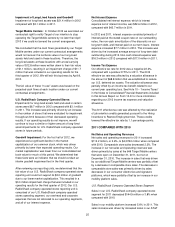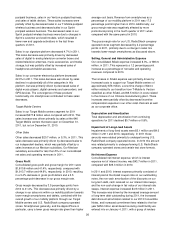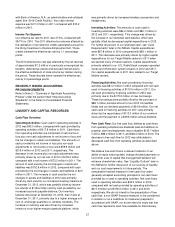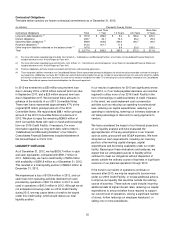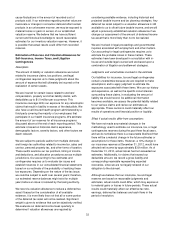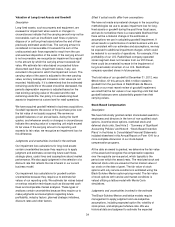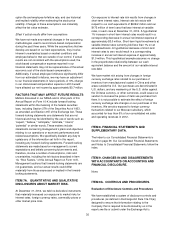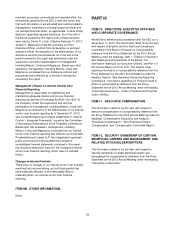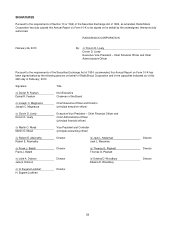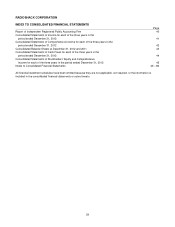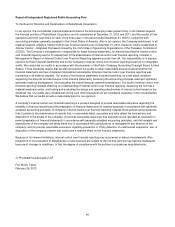Radio Shack 2012 Annual Report Download - page 34
Download and view the complete annual report
Please find page 34 of the 2012 Radio Shack annual report below. You can navigate through the pages in the report by either clicking on the pages listed below, or by using the keyword search tool below to find specific information within the annual report.32
Revenue Recognition
Description
Our revenue is derived principally from the sale of name
brand and private brand products and services to
consumers. Revenue is recognized, net of an estimate for
customer refunds and product returns, when persuasive
evidence of an arrangement exists, delivery has occurred
or services have been rendered, the sales price is fixed or
determinable, and collectability is reasonably assured.
Certain products, such as wireless telephone handsets,
require the customer to use the services of a third-party
wireless service provider. The wireless service provider
pays us an upfront commission for obtaining a new
customer or upgrading an existing customer and, in some
cases, a monthly recurring residual amount based upon the
ongoing arrangement between the service provider and the
customer. For certain new customers the upfront
commission revenue is repaid to the wireless service
provider if the wireless handset is subsequently deactivated
from the wireless network during a specified period. Our
sale of an activated wireless handset is the single event
required to meet the delivery criterion for both the upfront
commission and the recurring residual revenue. Upfront
commission revenue, net of estimated wireless service
deactivations, is recognized at the time an activated
wireless handset is sold to the customer at the point-of-
sale. Recurring residual revenue, which is not fixed and
determinable at the point of sale, is recognized as earned
under the terms of each contract with the wireless service
provider, which is typically as the wireless service provider
bills its customer, generally on a monthly basis.
Judgments and uncertainties involved in the estimate
Our revenue recognition accounting methodology requires
us to make certain judgments regarding the estimate of
future sales returns and wireless service deactivations. Our
estimates for product refunds and returns, wireless service
deactivations and commission revenue adjustments are
based on historical information pertaining to these items.
Based on our extensive history in selling activated wireless
handsets, we have been able to establish reliable estimates
for wireless service deactivations. However, our estimates
for wireless service deactivations can be affected by certain
characteristics of and decisions made by our service
providers. These factors include changes in the quality of
their customer service, the quality and performance of their
networks, their rate plan offerings, their policies regarding
extensions of customer credit, and their wireless handset
product offerings. These factors add uncertainty to our
estimates.
Effect if actual results differ from assumptions
We have not made any material changes in the
methodology used to estimate sales returns or wireless
service deactivations during the past three fiscal years. We
continue to update our estimate for wireless service
deactivations to reflect the most recently available
information regarding the characteristics of and decisions
made by our service providers discussed above. If actual
results differ from our estimates due to these or various
other factors, the amount of revenue recorded could be
materially affected. A 10% difference in our reserves for the
estimates noted above would have affected net sales and
operating revenues by approximately $5.6 million in 2012.
Inventory Valuation
Description
Our inventory consists primarily of finished goods available
for sale at our retail locations or within our distribution
centers and is recorded at the lower of cost - on a first-in
first-out basis - or market. The cost components recorded
within inventory are the vendor invoice cost, which is net of
vendor allowances, and certain allocated freight,
distribution, warehousing and other costs relating to
merchandise acquisition required to bring the merchandise
from the vendor to the location where it is offered for sale.
Judgments and uncertainties involved in the estimate
Typically, the market value of our inventory is higher than
its aggregate cost. Determination of the market value may
be very complex and, therefore, requires a high degree of
judgment. In order for management to make the
appropriate determination of market value, the following
items are commonly considered: inventory turnover
statistics, current selling prices, seasonality factors,
consumer trends, competitive pricing, performance of
similar products or accessories, planned promotional
incentives, technological obsolescence, and estimated
costs to sell or dispose of merchandise such as sales
commissions.
If the estimated market value, calculated as the amount we
expect to realize, net of estimated selling costs, from the
ultimate sale or disposal of the inventory, is determined to
be less than the recorded cost, we record a provision to
reduce the carrying amount of the inventory item to its net
realizable value.
Effect if actual results differ from assumptions
We have not made any material changes in the
methodology used to establish our inventory valuation or
the related reserves during the past three fiscal years, and
we do not believe there is a reasonable likelihood that there
will be a material change in the future estimates or
assumptions we use to estimate our inventory valuation
reserves. Differences between management estimates and
actual performance and pricing of our merchandise could
result in inventory valuations that differ from the amount
recorded at the financial statement date and could also





